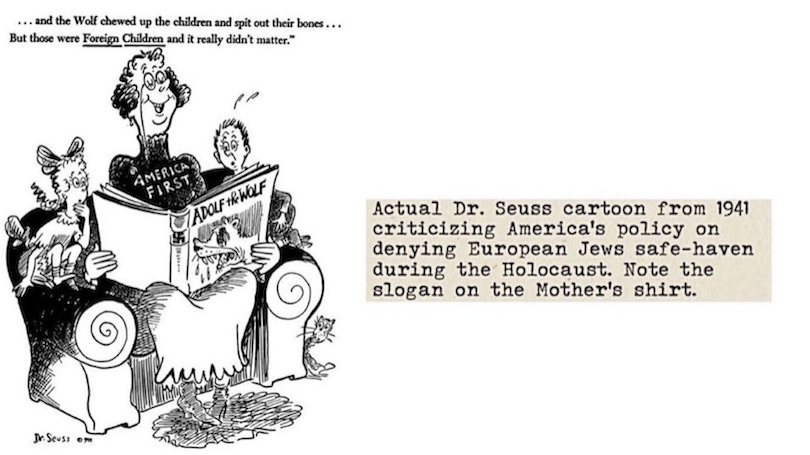
- About
- Humanities Networks
- Faculty
- Students
- Postdocs
- News & Events
Back to Top Nav
Back to Top Nav
Back to Top Nav
Back to Top Nav
Old-School Dr. Seuss Drawings Skewer Fascism One Frightening Drawing At A Time
From the Huffington Post
Priscilla Frank Arts Writer, The Huffington Post
Priscilla Frank Arts Writer, The Huffington Post
While Theodore Geisel ― better known as Dr. Seuss ― is frequently celebrated for rhyming “cat” with “hat” and “one fish, two fish” with “red fish, blue fish,” the iconic children’s book author and illustrator could deliver a razor-sharp political cartoon, too.
Between 1941 and 1943, a decade before he published The Cat in the Hat, Seuss drew over 400 comics for the left-wing political magazine PM.
Seuss, of Jewish German descent and raised in Springfield, Massachusetts, was devastated by Adolf Hitler’s rise to power and similarly outraged by America’s initial ambivalence to it. “I think he just got mad,” Judith Morgan, coauthor of the book Dr. Seuss and Mr. Geisel, said in an interview with The Atlantic. “He saw the growing threat in Europe and thought the Americans were not paying attention.”
Drawing in his signature style of swooping trees with cloud-like leaves, Seuss lambasted Hitler and everything he stood for. In his cartoons he rendered the fascist dictator as a mad scientist, a trophy hunter, and a bureaucrat giving orders to the devil. Although somewhat childlike in their aesthetic, Seuss’ drawings tackled the most terrifying 20th-century issues plaguing Germany and beyond.
Some of Seuss’ most insightful cartoons, posted online by Imgur user moriartytheking, have been making the rounds on the internet recently, for obvious reasons. While a significant portion of the U.S. struggles to determine whether the appropriate reaction to President-elect Donald Trump’s win should be one of disappointment or utter terror, Seuss’ drawings present an example of what it looks like to witness and resist through art.
Today’s authors have not shied away from drawing certain parallels between 1940s Germany and contemporary America. As author Chimamanda Ngozi Adichie wrote in an essay for The New Yorker: “Now is not the time to tiptoe around historical references. Recalling Nazism is not extreme; it is the astute response of those who know that history gives both context and warning.”
Seuss’ drawings are another reminder of the subversive role artists and writers can play in the coming years. And if they do it with rhyming couplets and adorable turtles, all the better.